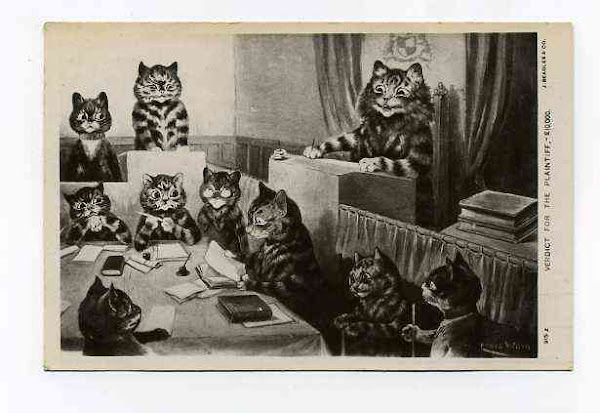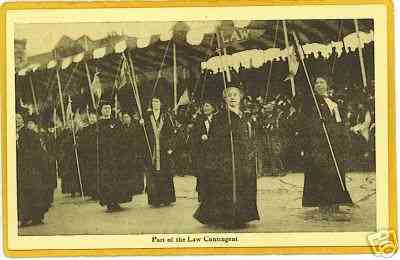Monday, March 31, 2008
Murray on Law Book Bindings
One of the subjects which David Murray discusses in his Legal Merriments is the history of the binding law books. He observes that the subject was not one which interested his contemporaries, a statement which would be true today as well. But, he pionts out that there have been learned disquistions published on the subject. Among the various opinions he cites is that of Sebastian Brant, best known for his Ship of Fools. Brant was a law professor at Basel and much interested in the organization of legal knowledge. He recommended that law book bindings be color coded, to reflect their contents. Thus, he argues that the Digestum Vetus be bound in white, for simplicty; the Infortiatum in black because it deals with succession and the property of the dead, the Digestum Novum in red because it deals with crimes; and theVolumen in green and red to signify that it deals with both recent laws and fiscal matters. [David Murray, Legal Merriments, pp. 266-267] It is interesting to speculate whether Brant's scheme of color coding bindings drew its inspiration from the medieval habit of illuminating law books with scenes which corresponded to the subjects discussed on the same and nearby pages, about which more in the next post.
Wednesday, March 19, 2008
David Murray

There are few books which provide greater pleasure to the legal antiquarian than David Murray's Lawyers' Merriments. Murray was an Edwardian Glasgow lawyer and antiquarian with a penchant for the obscure and the amusing. He published a number of works on legal and Scottish history, among which his Lawyers' Merriments, published at Glasgow by Maclehose in 1912, is his best/ He includes chapters on such things as legal lyrics, lawyers' libraries, facetious precedents, comic textbooks, and the relationship between the Devil and the legal profession. Over the course of the next few weeks I shall provide extracts from this volume with commentary.
Wednesday, March 12, 2008
The North American Legal Association

New York lawyer, publisher, and entrepreneur, John Livingston, founded the North American Legal Association [also known as the American Legal Association] in the early 1850s. It was a loose organization of lawyers from throughout the United States created to provide those doing interstate business a list of reliable legal counsel. Livingston distributed circulars advertising the group to postmasters and county clerks and solicited them to recommend potential Association members. He also advertised the group in his law journal, Livingston's Monthly Law Journal. Within a few years he was able to list members throughout the United States. The Association was one of the first national proto-bar associations in the U.S. A certificate of membership in the Association is illustrated above.
For more information on Livingston and his various enterprises, see my article, "John Livingston & the Business of Law in Nineteenth Century America," American Journal of Legal History, v.44 (2000), pp. 347-368.
Monday, March 10, 2008
Dressing Like a Lawyer
 The portrait, above, is of an early nineteenth century American lawyer.
The portrait, above, is of an early nineteenth century American lawyer. A number of years ago when former Chief Justice Rehnquist decided to add adornments to his judicial gown, I received a telephone call from a reporter asking about the history of legal and judicial dress. I was able to give her a reasonable answer based on a file which I keep. Here are a few sources on the subject:
--W.N. Hargreaves-Mawdsley, A History of Legal Dress in Europe Until the Eighteenth Century (Oxford:OUP, 1963)
--J.H. Baker, "History of the Gowns of the English Bar," Costume, no.9 (1975), pp.15-21
--Charles M. Yablon, "Judicial Drag: An Essay on Wigs, Robes, and Legal Change," Wisconsin Law Review (1995), pp.1129-1153
--Susan L'Engle, "Addressing the Law: Costume as Signifier in Medieval Legal Miniatures," in
D. Koslin & J. Snyder, Encountering Medieval Textiles and Dress. Objects, texts, Images
(N.Y.: Palgrave, 2002), pp. 137-172
For those wishing to pursue this subject further a good starting point is:
--Valerie Cumming, Understanding Fashion History (London: Batsford, 2004)
Thursday, March 6, 2008
A Legal Draught

The stein pictured above is one of a number of "book steins" created by the Mettlach Company of Leipzig, Germany in the last decade of the nineteenth century. The series of steins consists of eleven "profession" steins and one memorial stein commissioned by Cornell University. Stein # 2001A in the Mettlach Catalogue is known as the "Lawyer Stein" since it is decorated with legal symbols and reproductions of law book spines. According to Steven Steigerwalt & John Lamb, authors of one of the leading articles on the Mettlach book steins, which I recommend highly,[http://www.beerstein.net/articles/s9412a.htm]:
"The inlay depicts a scale hung from a sheathed sword. A king’s crown on one scale pan is balanced against a peasant’s hat on the other. The decoration symbolizes the principle that justice (symbolized by the sword) is evenly dispensed or administered regardless of social status (symbolized by the crown and peasant hat balancing the scale). The inlay bears the latin saying “FIAT JUSTITIA PER: MUN” which translates as “Let there be justice throughout the world.”
The titles of the eleven books depicted on the stein body are predominately Latin. They are: Lib. Pand. volumes 1 and 2; Corpus Institutionum Justiniani by Diling dated 1574; Peinl. Ger. Ordnung (German Penal Regulations) by K. Karoli dated 1532; De Pace Publica, dated 1586; Corpus Juris Civilis: Practica Lanfranci, dated 1528; C. J. C. by Gotofred from Geneva dated 1624; Volumen Legum Parvum by Venetiis, dated 1597; Practice Juris and Viatoriu Utriusque Juris. These books detail the civil and penal statutes which prescribe the code of conduct on which justice is based, the principles of law and the means that are used in the administration of the law."
The titles of the eleven books depicted on the stein body are predominately Latin. They are: Lib. Pand. volumes 1 and 2; Corpus Institutionum Justiniani by Diling dated 1574; Peinl. Ger. Ordnung (German Penal Regulations) by K. Karoli dated 1532; De Pace Publica, dated 1586; Corpus Juris Civilis: Practica Lanfranci, dated 1528; C. J. C. by Gotofred from Geneva dated 1624; Volumen Legum Parvum by Venetiis, dated 1597; Practice Juris and Viatoriu Utriusque Juris. These books detail the civil and penal statutes which prescribe the code of conduct on which justice is based, the principles of law and the means that are used in the administration of the law."
The Mettlach "Lawyer Stein" is not rare. It frequently is found for sale on Ebay and other online auction sites for $500-$750, depending on condition. It is also not a unique idea. Cornell University [which commissioned one of the "book series" steins, as noted, also produced legal-themed steins for its annual law school "smokers" at the turn of the twentieth century.
Wednesday, March 5, 2008
Welcome
Welcome to my new Blog, the Legal Antiquarian. This Blog will be devoted to the history of the material culture of the law, i.e. to the various aspects of legal history having to do with the daily life of lawyers and judges, as well as to the sources, manuscript, printed, and otherwise preserved which can be used to help understand how law and the legal profession functioned in the past Among the subjects I will cover will be the daily lives of lawyers, their practices, their offices, the books they owned and read, etc. I will also post quotes on this Blog from little-known sources about the law, such as postcards, trade cards, and other ephemera. I'll also try to alert readers to new books, articles and online sources on these aspects of legal history.
The pictures on the bottom of this page will change, as the mood suits me. For the most part what I will post will be items about the law and legal profession from my collection. Currently, there are two illustrations at the bottom. The first is a trade card, i.e. an advertising card, from the ast quarter of the nineteenth century. It was printed in color by the chromolithographic process. The illustration of a court in which the participants are all animals is partof a long tradition, going back to the Middle Ages.
The second illustration is of a postcard dating from between 1908-1912. It is obviously of a law congress of some sort, perhaps, the Comparative Law Conference held at St. Louis, in which a contingent of women lawyers proudly march.
The pictures on the bottom of this page will change, as the mood suits me. For the most part what I will post will be items about the law and legal profession from my collection. Currently, there are two illustrations at the bottom. The first is a trade card, i.e. an advertising card, from the ast quarter of the nineteenth century. It was printed in color by the chromolithographic process. The illustration of a court in which the participants are all animals is partof a long tradition, going back to the Middle Ages.
The second illustration is of a postcard dating from between 1908-1912. It is obviously of a law congress of some sort, perhaps, the Comparative Law Conference held at St. Louis, in which a contingent of women lawyers proudly march.
Subscribe to:
Posts (Atom)


